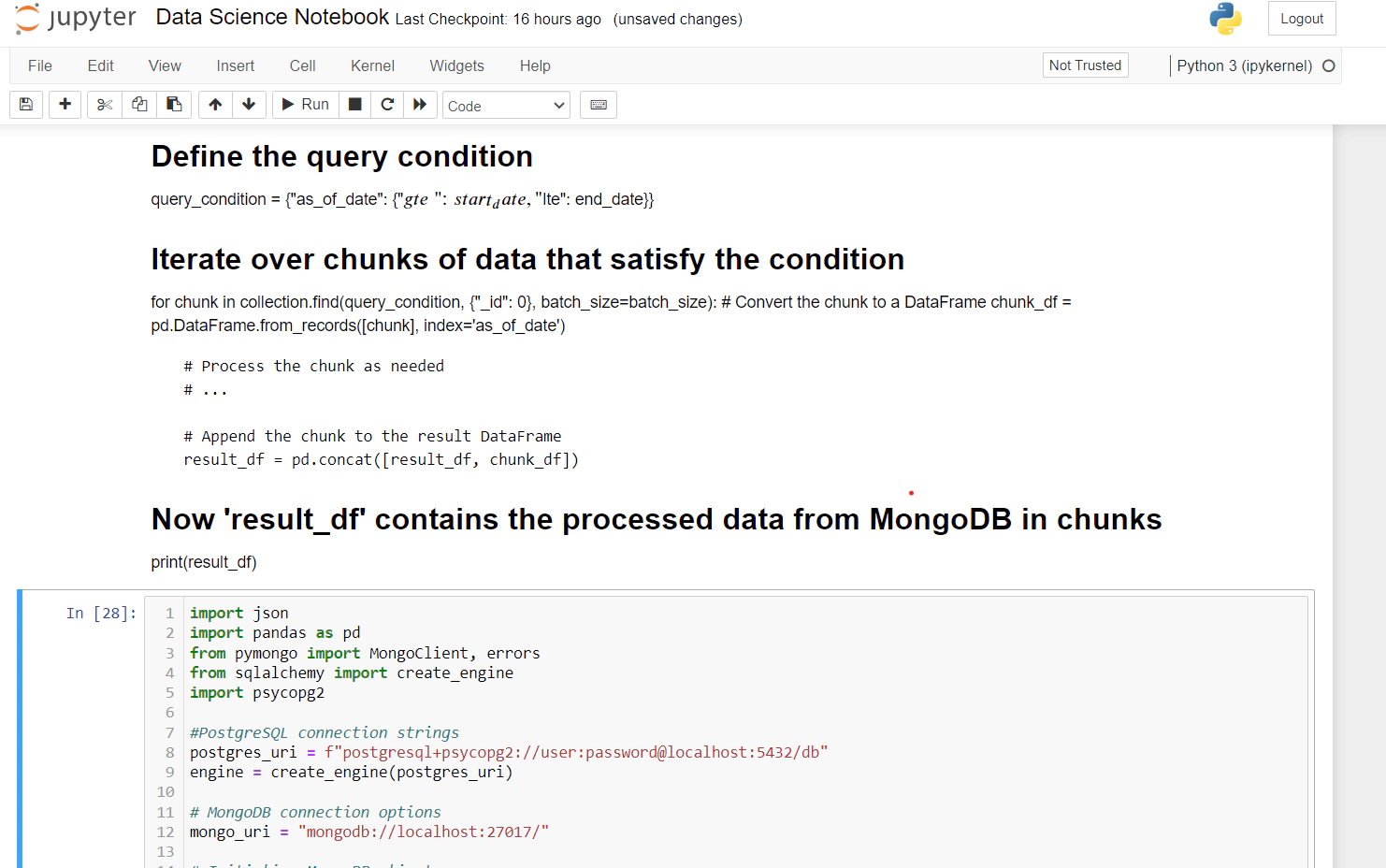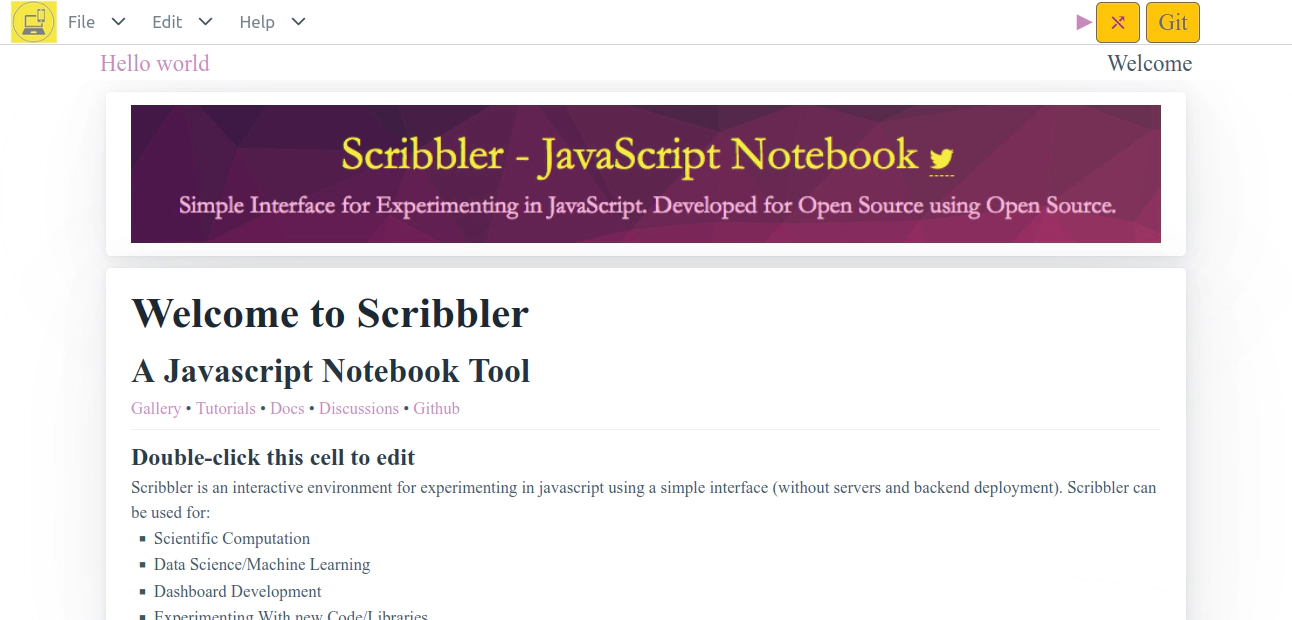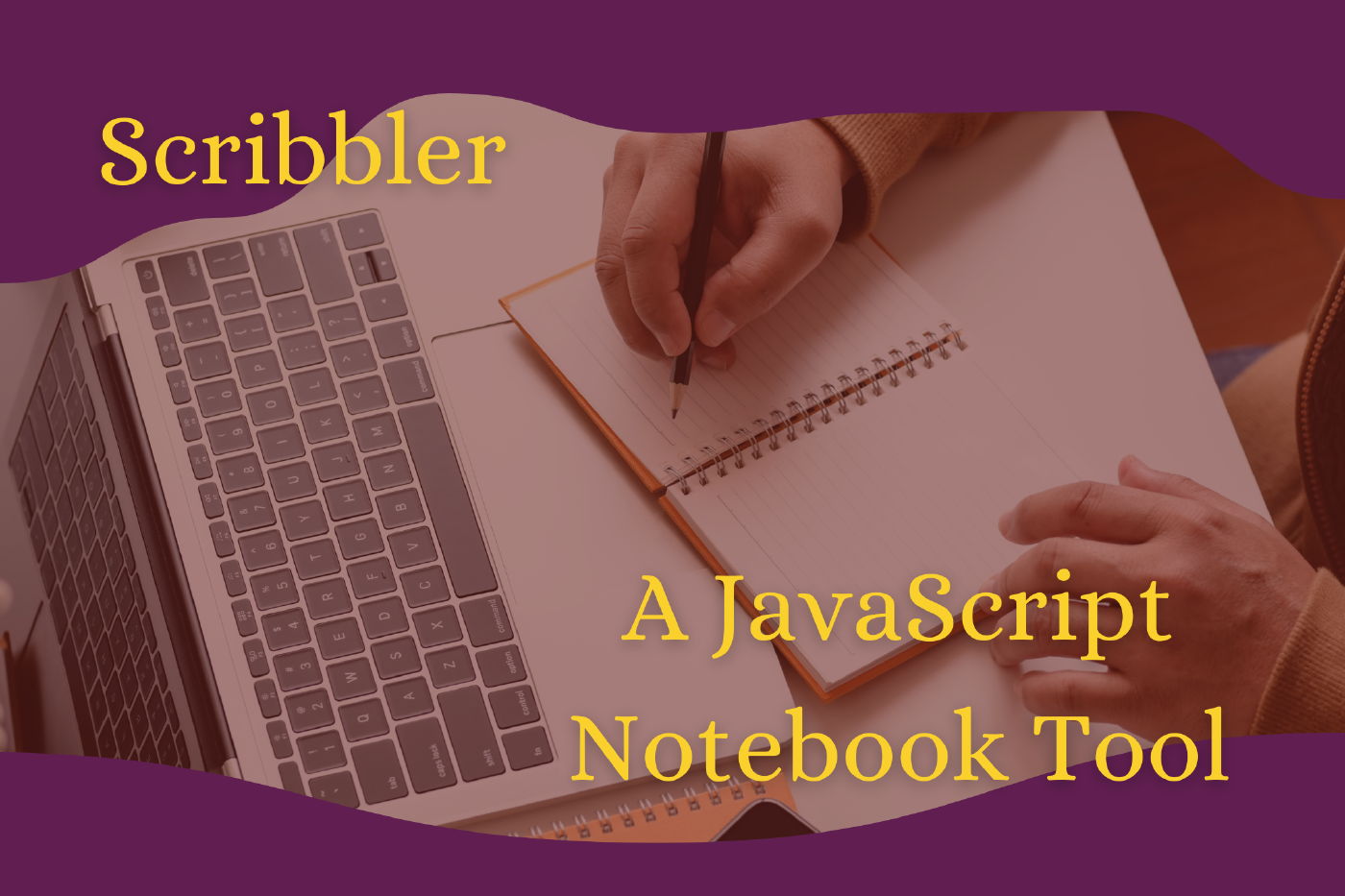Scribbler - Experiment in JavaScript Using a Notebook Environment
Need for a Notebook Tool
A notebook tool is an interactive software environment that combines code execution, visualizations, and explanatory text in a structured, document-like format. Its purpose is to facilitate experimentation, documentation, and collaboration in programming and data analysis. Jupyter Notebook stands as one of the most popular tools for the Python programming language.

Notebooks foster a seamless workflow for developers, data scientists, and educators. These tools promote an iterative approach to coding, enabling quick experimentation, troubleshooting, and refinement of ideas. Their support for multiple libraries, combined with the ability to integrate code with rich-text explanations, empowers users to explore complex concepts, prototype algorithms, visualize data, and effortlessly share insights. Notebook tools serve as invaluable resources, not only for individual coding endeavors but also for fostering learning, collaborative work, and the advancement of innovative solutions across various domains.
A notebook tool can be immensely helpful for experimentation and prototyping due to its interactive, organized, and iterative nature. Here’s how it can assist:
- Providing immediate feedback through live execution and visual output.
- Supporting documentation in the form of HTML/Markdown cells and in-line comments.
- Facilitating iterative development through incremental testing.
- Enabling data exploration and visualization.
- Allowing exploration of libraries and APIs.
- Serving educational and scientific purposes.
- Supporting collaboration on code development.
Scarcity of Notebook Tools for JavaScript
Python has historically dominated the data science and scientific computing landscape, leading to more investment and development in notebook tools tailored for Python. Consequently, this dominance has resulted in a broader ecosystem of libraries, support, and community around Python-based notebooks.
Creating a robust notebook environment for JavaScript involves complexities due to the asynchronous nature of JavaScript, which differs from Python’s synchronous execution commonly used in popular notebook environments like Jupyter.
However, despite the limited number of dedicated JavaScript notebook tools, efforts are being made to bridge this gap. Projects like Observable and Jupyter Notebook with JavaScript kernels (such as IJavascript or Node.js kernel) offer ways to work with JavaScript in notebook-like environments. Additionally, online code editors and platforms like CodePen, and JSFiddle, provide interactive JavaScript coding environments, albeit in a slightly different format from traditional notebooks.
As JavaScript’s role continues to evolve and expand beyond web development, there is increased interest and development in creating more open-source notebook tools tailored for JavaScript in the future.
There’s a growing need for a new tool resembling Jupyter but leveraging the browser’s runtime due to JavaScript’s inherent connection to web technologies. This approach enables seamless integration of web APIs, real-time visualization, and utilization of the browser’s capabilities for a more native and interactive coding experience. However, there are currently very few robust options available to address this need, especially in the open-source domain.
Scribbler - An Open Source Notebook Tool

Scribbler is an open-source tool designed to bridge this gap by leveraging the browser’s runtime, akin to Jupyter. To begin using Scribbler, you can easily access the hosted version at https://app.scribbler.live. Upon accessing, it opens a “Hello World” notebook. You can also open a new blank notebook through File -> New Blank NB. For the “Hello World” code, simply type:
show("Hello World")
and then click the play button or use Ctrl + Enter. Additional comprehensive examples and use-cases are available in the gallery here: https://scribbler.live/samples.html. Documentation for Scribbler can be found here: https://scribbler.live/docs.html
Scribbler offers several features tailored for JavaScript experimentation and prototyping:
-
Browser Integration: By leveraging the browser’s runtime environment, Scribbler seamlessly integrates with web APIs, facilitates DOM manipulation, and enables real-time interactions, allowing users to work directly with web technologies.
-
Interactive Visualizations: Using JavaScript libraries and frameworks, Scribbler empowers users to create real-time visualizations within the notebook interface. This functionality supports data analysis, graphing, and interactive displays, utilizing the browser’s rendering capabilities.
-
Web-based Collaboration: Scribbler encourages collaborative coding by providing mechanisms for pushing to and pulling from GitHub seamlessly. This facilitates teamwork and near-real-time interaction among collaborators.
-
HTML-based Documentation: Scribbler supports HTML for documentation alongside JavaScript code, enabling users to embed rich media, create structured content, and provide explanations directly within the notebook interface.
-
Notebook Persistence: Offering features to download, export, and share notebooks, Scribbler ensures users can easily revisit and share their experiments. This functionality supports reproducibility and enables the sharing of findings with others.
-
Flexibility and Extensibility: Scribbler’s design accommodates various JavaScript libraries and extensions, giving users the flexibility to customize and expand its functionalities based on individual needs and preferences. As Scribbler is open-source, it can be forked and modified to suit more specific uses.
Use-cases for Scribbler
Scribbler, emphasizing the utilization of the browser’s runtime for JavaScript experimentation, caters to a wide array of use cases:
-
Web Development Prototyping: Ideal for web developers, Scribbler offers a platform to prototype and experiment with new JavaScript features, test APIs, and iterate rapidly on front-end code directly within the browser environment.
-
Data Visualization and Analysis: Valuable for data scientists and analysts, Scribbler facilitates exploratory data analysis, creation of interactive visualizations using JavaScript libraries like D3.js, Plotly, or Chart.js, enabling insights through real-time visual representations.
-
Educational Tool for JavaScript Learning: Serving as an interactive learning platform, Scribbler supports JavaScript education by enabling learners to experiment with code, visualize concepts, and witness immediate results, making it an invaluable resource for coding tutorials and workshops.
-
Real-time Collaborative Coding: Beneficial for teams engaged in web-related projects, Scribbler’s collaborative features enable multiple developers to collaborate within a single notebook, share code snippets, and work together in real-time.
-
API and Library Testing: Useful for testing various JavaScript libraries, frameworks, and APIs within a sandboxed environment. This allows developers to explore functionalities, experiment with different configurations, and understand usage without affecting production environments.
-
Interactive Documentation and Prototyping: Suitable for JavaScript developers aiming to create interactive documentation or prototype new features, Scribbler allows embedding HTML-based documentation alongside code, facilitating detailed explanations, examples, and live demonstrations.
-
Rapid Code Experimentation: Providing an iterative environment, Scribbler allows instant execution and modification of JavaScript code segments for quick code validation, debugging, or experimenting with new algorithms.
-
Interactive Presentations and Demonstrations: Employable for creating interactive presentations or demonstrations displaying JavaScript-based projects. Scribbler enables live code execution and dynamic visualizations during presentations or workshops.
-
Scientific Computing: For scientific computing needs, Scribbler supports experimentation and dynamic analysis using various JavaScript libraries.
Looking Forward to Comments and Contributions
Join us in exploring Scribbler! Whether you’re a web developer, data scientist, educator, or part of a collaborative team, Scribbler offers a versatile platform for JavaScript prototyping, data visualization, collaborative coding, and interactive learning.
Visit our website to discover the tool’s capabilities, access comprehensive documentation, explore a gallery of examples showcasing its potential applications, and dive into the GitHub repository housing the codebase. Your feedback, comments, and contributions are invaluable to us as we strive to enhance Scribbler’s features and usability.
Experience the possibilities with Scribbler and join us in shaping the future of interactive JavaScript coding environments. Your input and engagement are pivotal as we continue to evolve and improve Scribbler for the JavaScript development community. Visit us and be a part of this innovative journey!
- Web site: https://scribbler.live
- Access the Tool (No Login Required): https://app.scribbler.live
- Gallery of Examples: https://scribbler.live/samples.html
- Source Code (GitHub): https://github.com/gopi-suvanam/scribbler
We wholeheartedly welcome your feedback, comments, and contributions!
Warm Regards,
- Gopi
PS: My book on liberal economics – Liberty & Prosperity (Vernon Press, 2021) is available at a 24% discount (use code CFC70366D8B0 at checkout).
Related Posts
Unveiling the Fascination of the Collatz Conjecture: Exploring Sequence Creation with JavaScript
The Collatz Conjecture, also known as the 3x+1 problem, is a fascinating mathematical puzzle that has intrigued mathematicians for decades. It has sparked publications with titles such as The Simplest Math Problem Could Be Unsolvable, or The Simple Math Problem We Still Can’t Solve because it is, indeed, rather simple-looking.
Read moreThe Art of Data Visualization: Exploring D3.js
Data is everywhere, flowing into our applications from various sources at an unprecedented rate. However, raw data alone holds little value unless it can be transformed into meaningful insights.
Read moreJavaScript’s Secret Weapon: Supercharge Your Web Apps with Web Workers
During an interview, I was asked how we could make JavaScript multi-threaded. I was stumped, and admitted I didn’t know… JavaScript is a single-threaded language.
Read more



